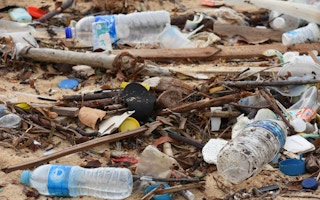We have long known that the accumulation of plastic in the world’s landfills and oceans represents a growing environmental risk. More recently, we have come to understand that plastic poses an urgent—even deadly—threat to public health, too. And yet, global efforts to address the plastic crisis remain consistently focused on the wrong end of the life cycle: waste management.
The debate that will resume this month at the United Nations Environment Assembly (UNEA-4) is a case in point, because it will focus on “marine litter and microplastics.” These are important issues, but they constitute just one small part of a much larger problem.
To be sure, plastic has played an essential role in global economic growth for decades. Its seemingly countless applications include life-saving medical devices, clothes, toys, various industrial and agricultural uses, and so on. Some have even touted plastic as part of the solution to climate change, arguing incorrectly that it has a smaller carbon footprint than other materials. In fact, plastic releases significant greenhouse gases like methane and ethylene as it decomposes in the land and marine environments.
In fact, 99 per cent of plastics are made from fossil fuels like coal, oil, and gas. And new research shows that plastic is harmful to our bodies at every stage of its life cycle, from its extraction as a fossil fuel to its widespread use as a packaging for food, and on through the waste-management process (which includes landfills, recycling centers, and incinerators).
One way or another, almost every organism on the planet is affected by the production, use, or disposal of plastic, the toxic effects of which linger and accumulate endlessly in the air we breathe, the water we drink, and the soil under our feet. Some of the leading impacts of plastic production include harm to the immune and reproductive systems, liver and kidney damage, and even cancer; as we move through the lifecycle of plastic products, the threats to reproductive systems and from cancer continue, with added harm to neurological development and other systems. Making matters worse, plastic production is increasing, and will continue to do so. The US plastics industry alone plans to boost production by 30 per cent in the next few years.
“
One way or another, almost every organism on the planet is affected by the production, use, or disposal of plastic.
Though the public associates plastic with life-saving wonder materials, an estimated 40 per cent of global plastic production is for single-use packaging. By design, it is used temporarily for transport and storage, and then simply thrown away. As a result, nearly 80 per cent of all the plastic ever produced has ended up either in a landfill or loose in the natural environment, despite years of industry messaging to encourage recycling. Not only do we lack the recycling capacity to manage the plastic already in circulation; recent innovations in recycling appear to be causing further damage to the environment and public health, through air pollution, toxic ash, and other externalities.
A debate that focuses solely on waste suits the plastics industry just fine. For years, producers have been investing in marketing and advertising campaigns to convince consumers that they themselves bear responsibility for the plastics crisis. And they and their lobbyists have been busy persuading governments—including those participating in the UNEA—that waste management should be their primary focus.
So far, these efforts have succeeded in preventing measures that would limit production, and therefore profits. When the industry spends $1 billion to launch a high-profile “Alliance to End Plastic Waste,” its real goal is to maintain the status quo, and to protect its $200 billion investment in expanded production over the next five years.
Still, there is cause for hope. Break Free From Plastic, a growing global movement of nongovernmental organizations, has been working to inform governments and their representatives of the harms and risks associated with new plastic production. In the 15 months since UNEA-3, an Ad Hoc Open-Ended Expert Group has met twice to assess the options available for addressing the plastic crisis holistically. Their findings, bolstered by multiple UN-sponsored analyses and independent reports, point to major gaps and insufficient coordination in current governance structures.
The Expert Group’s recommendations have given significant momentum to the push for a new global framework to reduce the production and consumption of plastic. At UNEA-4, a resolution proposed by Norway calls for stronger global-governance structures to address marine litter and microplastics. But the hope is that this will serve as a first step toward a legally binding treaty with a multi-layered approach to solving the problem.
A new global convention to confront the plastics crisis would improve coordination between governments and existing regulatory structures, and would also provide additional financial and technical support. More importantly, its central focus would be preventing both growth in plastics pollution and harm to human health at all phases of the production cycle.
We all have a right to live in a healthy environment. But that right will not be secure until we adopt legally binding measures to limit production of plastics, and to hold companies and governments accountable for the damage plastic does to our bodies, communities, and ecosystems. Educating people about the importance of recycling is not enough. We are optimistic that the UNEA will recognize this and join with those who are already leading a groundbreaking initiative to protect human and environmental health.
Lili Fuhr heads the International Environmental Policy Division at the Heinrich Böll Foundation. Jane Patton, a global anti-plastic activist and campaigner, is the interim coordinator for the US region of the Break Free From Plastic movement.
Copyright: Project Syndicate, 2019.
www.project-syndicate.org










